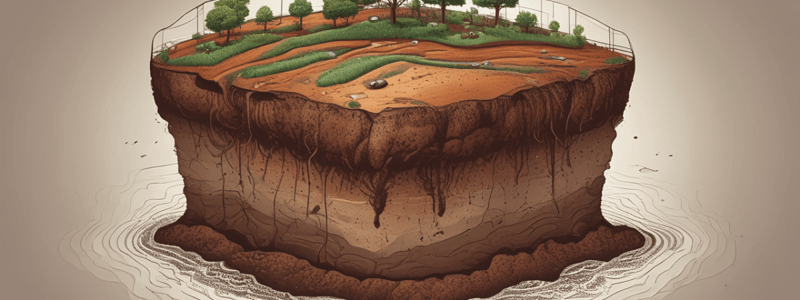Podcast
Questions and Answers
What is the primary purpose of flocculation in soil?
What is the primary purpose of flocculation in soil?
- To improve soil fertility
- To reduce soil structure
- To increase soil pH
- To improve soil structure (correct)
What type of particles have a higher negative charge?
What type of particles have a higher negative charge?
- Humus particles
- Clay particles
- Smaller particles (correct)
- Larger particles
What is the role of cations in flocculation?
What is the role of cations in flocculation?
- To adsorb to the surface of soil particles (correct)
- To attract soil particles
- To reduce soil pH
- To repel soil particles
Why is high humus content more beneficial than high clay content?
Why is high humus content more beneficial than high clay content?
What is the definition of Cation Exchange Capacity (CEC)?
What is the definition of Cation Exchange Capacity (CEC)?
Which type of soil has the lowest Cation Exchange Capacity (CEC)?
Which type of soil has the lowest Cation Exchange Capacity (CEC)?
What is the optimal pH range for cation exchange to occur?
What is the optimal pH range for cation exchange to occur?
What does soil pH measure?
What does soil pH measure?
Flashcards are hidden until you start studying
Study Notes
Flocculation
- Flocculation is the clustering together of soil particles to form larger structures called floccules.
- Improvement of soil structure is promoted by the presence of cations.
- Soil particles have a negative charge, with smaller particles having more negative charges.
- Cations (Ca2+, Mg2+) are attracted to these negative charges and are adsorbed to the surface of soil particles.
- Polarized water holds soil particles together, trapping larger sand and silt in a floccule structure.
Benefits of High Humus Content
- Humus is more fertile than clay.
- Humus holds more water than clay.
- Humus has a higher Cation Exchange Capacity (CEC) than clay.
- Humus encourages more earthworm activity than clay.
- Humus has more negative charges, resulting in an increased rate of flocculation.
Cation Exchange
- Cation exchange is the ability of the soil to adsorb cations onto its surface and exchange them for other cations.
- Cations are attracted to the negative charge of clay/humus particles and are adsorbed on the surface.
- Cations are removed from soil solution by plant roots.
- Colloidal humus particles have a higher CEC than colloidal clay particles.
- Cation Exchange Capacity (CEC) is the ability of the soil to adsorb cations onto its surface.
- Main cations are Ca2+, Mg2+, Al3+, H+, K+.
- Nitrate () cannot be held by the soil.
- Sandy soils have the lowest CEC.
Soil pH
- Soil pH is the acid-base scale, measuring the concentration of H+ ions in a solution.
- Acidic: pH < 7, Neutral: pH = 7, Basic: pH > 7.
- The concentration of acidic ions adsorbed onto the surface of the soil determines the acidity of the soil.
- Importance of Soil pH:
- Lime increases Ca cations available for exchange (H, K, Al).
- Liming reduces 'acid leaching'.
- Key points to note: Lime moisture content must be suitable for application.
Studying That Suits You
Use AI to generate personalized quizzes and flashcards to suit your learning preferences.




